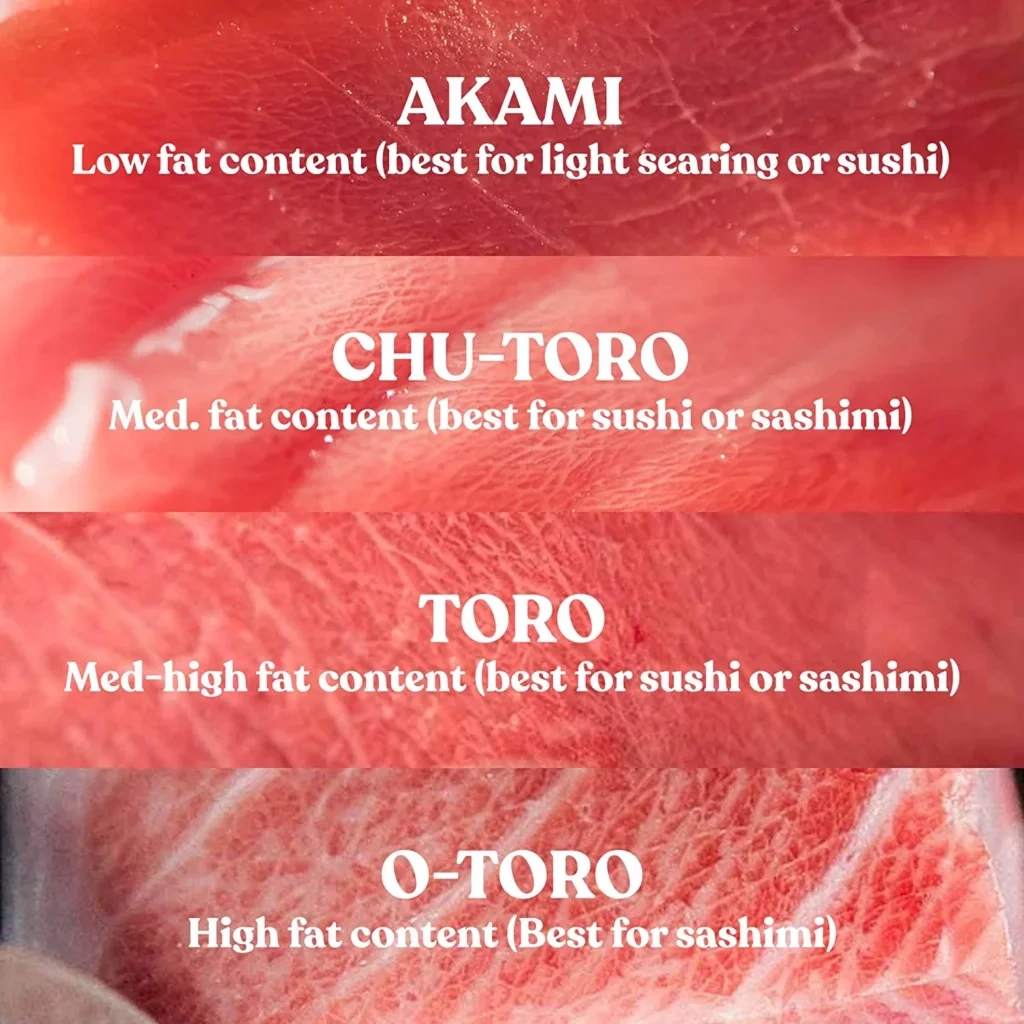Tuna Part Classification part 1 – Why tuna meat is different from other fish, meaning of toro and kama, Sections of the tuna honmaguro – belly and back region


Why tuna meat is different from other fish and similar to terrestrial animals
Most of the mammal meat such as pork and beef and the poultry like chicken we consume are all endothermic animals(warmblooded), thus regulate their own temperature.
Most fish are exothermic animals(coldblooded) so they cannot regulate their own body temperature. Also fish cells have higher water composition compared with terrestrial animals.




Tuna are one of the rare fish species that are endothermic, thus have a similar cell structure with terrestrial animals.
Also, tuna cell has a water component that is about 60-65% which is lower than other fish while similar to terrestrial animals or even lower than them.
Thus, overall, tuna physiology and cell components with less water composition make it similar to terrestrial animals and differentiate taste from other fish species.


Why the tuna belly is called a maguro toro/doro in Japanese
In Japanese the stomach and belly is called hara(はら:腹] while fat or flesh means mi(み:身) that is described for other fish belly parts ex) sea bream harami means sea bream belly.
The term ‘toro’ that usually refers to the belly part of the tuna derived from the Japanese word torokeru(とろける). The term torokeru means “melt away’ or ‘become seduced’ or ‘become enchanted/dazzled’.




Due to the taste that melts away and the rich flavor of the tuna belly, maguro toro became a term to describe the tuna belly.
Tuna Ottoro means ‘melts a lot’ as ‘oh oh’ means ‘big’ while chu or ju means middle Otoro(Odoro) 大トロ refers to the most oily part of the tuna belly while the chutoro(chudoro, judoro) 中トロ means the second oily part of the tuna belly


The Kama of fish, slice between the gills and the fin, the neck of the fish – Best part of all fish
In South Korea there is an old proverb (魚頭一味) 어두일미 that means the head of the fish is the most delicious. This may sound disgusting but it has scientific evidence as the oil contents of a fish is higher towards the head while lower towards the tail.
Thus the fish’s original flavor and taste is strongest towards the head. The ‘kama’ part of the fish which refers to the part between the gills and the pectoral(side fins) are thus the flesh and meat with the richest flavor of the fish.


Thus the ‘kama’ meat of fish is the most expensive part. ‘Kama’ means a sickle (かま) that looks like a collar and it became a Japanese word to describe the neck part of fish.
Among all the parts of the Tuna, the kama part is always the most expensive part and this is applicable for most fish in Japan and even South Korea.




Definition of Loin
1 : an area on the back of an animal's body near the tail; 2 : meat from this area.
The loins, or lumbus, are the sides between the lower ribs and pelvis, and the lower part of the back.
Many confuse the definition of loin and thinks loin means dividing into 4 parts. However tuna loin refers to the back side of the tuna that is usually the lean akami(red meat) part.




Division of the Tuna from head to tail – anterior to posterior
The tuna is divided into three sections from the head to the tail axis(anterior to posterior) The front section is called the kami(かみ) The middle is called naka(なか) and the section near the tail is called shimo(しも)


Division of the Tuna from belly to the back – ventral to dorsal
The tuna is also divided into two sections where the back part(loins) are referred to as the se(せ) and the belly part is called hara(はら).


Division of Tuna carcass parts into six – ventral to dorsal x anterior to posterior
Combined together with the anterior-posterior axis and the ventral to dorsal axis, the tuna carcass could be divided into six parts.


Back of the tuna – Usually the akami and the Setoro(some call also call this chutoro but the back part meat closer to the skin is much leaner than the belly part)
back-front – sekami(せかみ)
back-middle – senaka(せなか)
back-end – seshimo (せしも)


Belly of the tuna – Most of these parts include the Ottoro and the Chutoro
Belly-front- harakami(はらかみ)
Belly-middle – haranaka(はらなか)
Belly-end – harashimo(はらしも)
*The tail is called the sitbbo(しっぽ). The sitbbo cross section is used to determine the tuna value in fishmarket auctions.




Market Value of each Tuna parts in terms of the six divisions
Tuna cuts of the belly region the hara region(はら) are much more specified and divided as the belly parts have the richest flavor and cut into more specific sections in the market.
For the back regions, the senaka(せなか) has the highest market value because although most of the back is the akami and setoro(chutoro) that is relatively lean, the senaka region has the most oil contents among the other back regions so it has much more flavor.


The value of the sekama is next where the seshimo region is the lowest value as most fish including tuna have less flavor and a rough and dry texture towards the tail region.
For the belly regions, more specific cuts are made in the market, however the harakami(はらかみ)is the highest valued followed by the haranaka(はらなか) and the harashimo(はらしも) region.
Scientifically most fish including tuna have much more oil composition towards the head so the front parts of the belly have much higher value than the tail regions. The oil of the fish(tuna) make the outstanding flavor of the fish.



